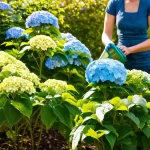Hydrangeas are profoundly captivating flowering plants known for their large, vibrant blooms and bushy appearance. Native to Asia and the Americas, these flowering shrubs come in over 70 species, presenting a diverse range in shapes, sizes, and color variations that make them a favorite among gardeners and landscaping enthusiasts alike.
Understanding Hydrangeas
Hydrangeas, scientifically classified under the genus Hydrangea, comprise species that thrive beautifully in various climates. They typically reach heights between 1 to 3 meters (3 to 10 feet) and can produce flower clusters ranging from delicate to exuberantly bold, showcasing an array of colors. Hydrangeas are generally categorized into several popular types including:
- Mophead (Bigleaf)
- Lacecap
- Panicle
- Smooth
- Oakleaf
Each type possesses unique characteristics, flowering periods, and cultivation needs.
Hydrangeas at a Glance
| Characteristic | Details |
|---|---|
| Genus | Hydrangea |
| Height | 1–3 meters (3–10 feet) |
| Blooming Period | Spring to Fall |
| Color Varieties | Blue, Pink, White, Purple, Green |
| Light Requirements | Full sun to partial shade |
| Soil Requirements | Well-drained, rich in organic matter |

Popular Varieties of Hydrangeas
- Mophead Hydrangeas: Known for their large, globe-shaped flower clusters, these hydrangeas are incredibly popular for their dramatic impact.
- Lacecap Hydrangeas: Featuring a flat flower cluster with inner fertile florets surrounded by larger outer florets, lacecaps offer a unique, delicate look.
- Panicle Hydrangeas: These shrubs produce elongated flower spikes that begin pale green and turn white or pink as they mature. They thrive in full sun and are known for their durability.
- Oakleaf Hydrangeas: With their distinctive oak-like leaves, these species provide beautiful fall color and stunning white blooms that age to pink.
- Smooth Hydrangeas: These hardy varieties feature large, round white blooms and are ideal for colder regions.
Hydrangea Color Changes
One of the most fascinating aspects of hydrangeas is their ability to change color based on soil pH levels. For instance:
- Alkaline Soil (pH 7 or higher): Produces pink flowers.
- Acidic Soil (pH 6 or lower): Results in blue flowers.
This phenomenon allows gardeners to play with soil acidity to achieve the desired hue.

Reference Video
Caring for Hydrangeas
To cultivate thriving hydrangeas, understanding their care requirements is essential. Below are key aspects of Hydrangea Care:
Watering
- Hydrangeas require consistent moisture, especially during dry spells. Water deeply once a week, ensuring water reaches the roots.
Pruning
- Proper pruning varies by hydrangea type but is generally done in late winter or early spring. Mopping head hydrangeas, for example, bloom on old wood, hence should be pruned just after flowering to maintain their shape and encourage new growth.
Fertilizing
- Use a balanced fertilizer during the growing season. A slow-release variety works best.
Sunlight Requirements
- Most hydrangeas prefer partial shade, especially in hotter climates. Full sun is acceptable for some varieties like panicle hydrangeas.

Pest and Disease Management
Common pests that affect hydrangeas include aphids, spider mites, and Japanese beetles. Fungal diseases can also pose threats, indicating a need for proper air circulation and humidity control. Using organic or chemical pesticides and ensuring good hygiene in your garden can mitigate these risks.
Ideal Soil Conditions
Hydrangeas thrive in rich, well-drained soil. A loamy mixture supplemented with compost yields optimal growth. Perform a soil test to assess pH levels and amend them accordingly.
| Soil Aspect | Ideal Conditions |
|---|---|
| Type | Loamy, well-draining |
| Moisture | Consistently moist |
| pH Level | Acidic for blue; Alkaline for pink |
| Nutrients | Rich in organic matter |
Propagating Hydrangeas
Hydrangeas can be propagated through several methods, including:
- Cuttings: Taking stem cuttings in early summer or late spring and placing them in water or soil can encourage new growth.
- Division: For mature hydrangeas, division involves splitting the root ball and replanting the sections.
- Layering: Bending a low-growing branch to the ground and covering it lightly with soil enables the plant to root naturally.
Understanding and employing these propagation methods can expand your hydrangea collection effortlessly.

Where to Buy Hydrangeas
If you’re looking to incorporate hydrangeas into your garden, consider visiting local nursery centers or online marketplaces. Sites like Monrovia offer a variety of hydrangeas for sale. Additionally, you may find unique picks at garden expos or floral shops, ensuring you choose healthy, well-developed plants.
FAQs About Hydrangeas
1. How much do hydrangeas cost?
The cost of hydrangeas varies significantly based on size and species, generally ranging from $15 to $100. Larger mature bushes often command higher prices.
2. What is the best time to plant hydrangeas?
The ideal time for planting hydrangeas is early spring or fall when temperatures are milder and soil moisture is more easily retained.
3. Can I grow hydrangeas in pots?
Yes, hydrangeas grow well in pots. However, it’s essential to ensure proper drainage and choose a suitable potting mix to encourage healthy growth.
4. What should I do if my hydrangeas stop blooming?
If your hydrangeas are not blooming, consider examining their sunlight conditions, watering frequency, and recent pruning practices, as stress or improper care could hinder flowering.
5. Are hydrangeas deer-resistant?
While not completely deer-proof, hydrangeas are less appealing to deer compared to Other flowering plants. Consider combining them with more fragrant or thorny plants to deter wildlife.
In summary, hydrangeas are magnificent flowering shrubs that can dramatically enhance any garden or landscape. With their breathtaking blooms and versatile forms, caring for these plants provides joy and beauty throughout the seasons. By following proper cultivation techniques and understanding their unique characteristics, one can appreciate the sheer elegance these plants contribute to outdoor spaces.


